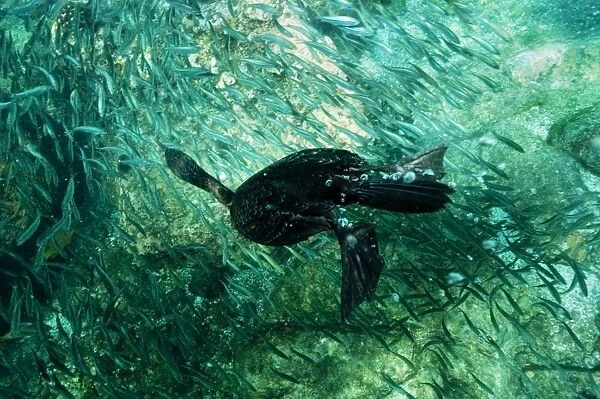Brandts cormorant
![]()

Wall Art and Photo Gifts from Science Photo Library
Brandts cormorant
Brandts cormorant (Phalacrocorax penicillatus), feeding on a bait ball of sardines, Los Islotes, La Paz, Baja, Mexico. Brandts cormorants, also known as brown cormorants, penciled cormorants or Townsends cormorants, are seabirds belonging to the family Phalacrocoracidae. Their principle food is live fish which is caught by diving from the surface and propelling underwater using their feet. Some species have been observed at depths of over 40 feet. Cormorant feathers do not have a waterproof oily layer. It is thought that this reduces drag and enables the bird to dive more quickly. After fishing the birds must go ashore to dry their wings. The formation of sardines into bait balls is an instinctual behaviour when threatened
Science Photo Library features Science and Medical images including photos and illustrations
Media ID 6465227
© LOUISE MURRAY/SCIENCE PHOTO LIBRARY
Bait Ball Bird Carnivore Carnivorous Cormorant Cormorants Diving Escaping Hunting Mexico Predator Preying Sea Bird Shoal Swimming Baja Brandts Cormorant La Paz Sardine Sardines
EDITORS COMMENTS
This print captures a mesmerizing moment in the underwater world of Los Islotes, La Paz, Baja, Mexico. A Brandts cormorant, also known as a brown cormorant or penciled cormorant, is depicted feeding on a bait ball of sardines. These seabirds are part of the Phalacrocoracidae family and rely on live fish as their primary source of sustenance. With remarkable agility and precision, the cormorant dives from the surface into the depths below to catch its prey. Some species have been observed diving at astonishing depths exceeding 40 feet. Unlike other birds with waterproof feathers, these magnificent creatures lack an oily layer that repels water. This unique adaptation reduces drag and allows them to dive swiftly. After a successful hunting expedition like this one captured in the photograph, Brandts cormorants must return to land to dry their wings since their feathers do not possess natural waterproofing abilities. The formation of sardines into bait balls is an instinctual behavior triggered when they feel threatened by predators such as these carnivorous birds. It serves as both protection and confusion tactic against potential attackers. Through this stunning image brought to us by Science Photo Library's collection on wildlife photography, we gain insight into the fascinating biology and behaviors exhibited by marine creatures like Brandts cormorants in their quest for survival amidst nature's intricate web of life beneath the waves.
MADE IN AUSTRALIA
Safe Shipping with 30 Day Money Back Guarantee
FREE PERSONALISATION*
We are proud to offer a range of customisation features including Personalised Captions, Color Filters and Picture Zoom Tools
SECURE PAYMENTS
We happily accept a wide range of payment options so you can pay for the things you need in the way that is most convenient for you
* Options may vary by product and licensing agreement. Zoomed Pictures can be adjusted in the Cart.

